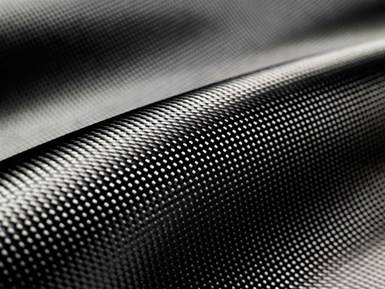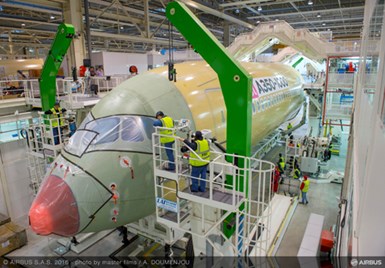Materials & Processes: Composites fibers and resins
Compared to legacy materials like steel, aluminum, iron and titanium, composites are still coming of age, and only just now are being better understood by design and manufacturing engineers. However, composites’ physical properties — combined with unbeatable light weight — make them undeniably attractive.
The modern use of composite materials in manufacturing is not new, spanning several decades, going as far back as the early 1960s. And before that, the combination of fiber with a liquid matrix has been employed in a variety of applications, ranging from tried and true dried mud and straw (adobe bricks) to a concept car developed by Ford Motor Co. (Detroit, Mich., U.S.) in 1941 that featured body panels made with natural fiber-reinforced composites.
Despite this, compared to legacy materials like steel, aluminum, iron and titanium, composites are still coming of age, and only just now are being better understood by design and manufacturing engineers. Further, composites are hindered by their non-isotropic nature, which makes them difficult to model and simulate. However, composites’ physical properties — combined with unbeatable light weight — make them undeniably attractive.
For the composites novice, fortunately, there is hope, and it lies in the fact that these materials can be easily understood and applied. What follows is a primer on the fibers and resins typically used in composites fabrication.
Winning properties
High strength and low weight remain the winning combination that propels composite materials into new arenas, but other properties are equally important. Composite materials offer good vibrational damping and low coefficient of thermal expansion (CTE), characteristics that can be engineered for specialized applications. Composites are resistant to fatigue and provide design/fabrication flexibility that can significantly decrease the number of parts needed for specific applications — which translates into a finished product that requires less raw material, fewer joints and fasteners and shorter assembly time. Composites also have proven resistance to temperature extremes, corrosion and wear, especially in industrial settings, where these properties do much to reduce product lifecycle costs. These characteristics have propelled composites into wide use. The push for fuel economy and efficiency, for example, has made lightweighting a priority in almost every mode of mechanical transportation, from bicycles to large commercial aircraft.

The Boeing 787 was the first commercial aircraft to use composites extensively in structural components. Almost every visible part of the plane — and many non-visible parts — are fabricated from carbon fiber/epoxy.
Since The Boeing Co.’s (Chicago, Ill., U.S.) 787 Dreamliner — 50% composite by weight and 100% composites on its aerodynamic surfaces — entered production and, in December 2009, successfully made its first flight, composites have earned their way into primary and secondary aerospace structures and found a greater place in the aircraft interior in the aerospace world. The 787 has since been joined in the world spotlight by other composites-intensive aircraft from its commercial transport aircraft rival, Airbus (Toulouse, France) and others. The first 52% composite Airbus A350 XWB was delivered as 2015 dawned. And Airbus previously incorporated composites into its A380 superjumbo passenger jet and its A400M military transport plane as well. The four programs are a present fulfillment of a long-awaited transformation that has also overtaken the general aviation aircraft market and has long been a part of military aircraft manufacture. Available in increasingly diverse material forms, and manufacturable by an extensive array of molding and forming processes — have taken or are poised to take the spotlight in manufacturing arenas throughout the world.
A definitively different material
Composites differ from traditional materials in that composite parts comprise two distinctly different components — fibers and a matrix material (most often, a polymer resin) — that, when combined, remain discrete but function interactively to make a new material, the properties of which cannot be predicted by simply summing the properties of its components. In fact, one of the major advantages of the fiber/resin combination is its complementary nature. Thin glass fibers, for example, exhibit relatively high tensile strength, but are susceptible to damage. By contrast, most polymer resins are weak in tensile strength but are extremely tough and malleable. When combined, however, the fiber and resin each counteract the other’s weakness, producing a material far more useful than either of its individual components.

The BMW i3 all-electric car is the first production vehicle to make significant use of composites, specifically in the structure surrounding the passenger compartment.
The structural properties of composite materials are derived primarily from the fiber reinforcement. Commercial composites for large markets, such as automotive components, boats, consumer goods and corrosion-resistant industrial parts, often are made from discontinuous, randomly oriented glass fibers, or continuous but non-oriented fiber forms. Advanced composites, initially developed for the military aerospace market, offer performance superior to that of conventional structural metals and now find applications in communication satellites, aircraft, sporting goods, transportation, heavy industry and in the energy sector in oil and gas exploration and wind turbine construction.
High-performance composites derive their structural properties from continuous, oriented, high-strength fiber reinforcement — most commonly carbon, aramid or glass — in a matrix that promotes processability and enhances mechanical properties, such as stiffness and chemical resistance.

Composites derive their properties from the combination of a fiber and resin matrix, which can be accomplished with one of several fabrication types, which will be covered in next month's newsletter.
Fiber orientation can be controlled, a factor that can improve performance in any application. In composite golf club shafts, for example, boron and carbon fibers oriented at different angles within the composite shaft enable it to take best advantage of their strength and stiffness properties and withstand torque loads and multiple flexural, compressive and tensile forces.
A matrix can be polymeric, ceramic or metallic. The polymer matrices most widely used for composites in commercial and high-performance aerospace applications are thermoset resins, consisting of polymer chains that are permanently cured into a crosslinked network when mixed with a catalyst, exposed to heat, or both. Curing usually occurs under elevated temperature and/or pressure conditions in an oven and/or vacuum bag or in an autoclave. Alternative but less used curing technologies include electron beam, ultraviolet (UV) radiation, X-ray and microwave processes.
The other most commonly used matrix type is thermoplastic (TP) resin, which is proving an increasingly popular option for composites manufacturers. Thermoplastic linear polymer chains are formed and can be reformed into shaped solids by melting or softening and then cooling the material. Often sold in sheet or panel form, thermoplastics can be processed by in-situ consolidation techniques, such as simple press forming to make tough, near-net shape parts without the autoclave or vacuum-bag cure required by thermosets. TP reformability offers the potential to correct anomalies or repair in-service damage.
Glass fibers
The vast majority of all fibers used in the composites industry are glass. Glass fibers are the oldest and the most common reinforcement used in most end-market applications (the aerospace industry is a significant exception) to replace heavier metal parts. Glass fiber weighs more than the second most common reinforcement, carbon fiber, and is not as stiff, but it is more impact-resistant and has a greater elongation-to-break (that is, it elongates to a greater degree before it breaks). Depending upon the glass type, filament diameter, coating chemistry (called “sizing”) and fiber form, a wide range of properties and performance levels can be achieved.

Glass fiber is the most commonly used fiber type in composites manufacturing and offers affordability, light weight and attractive properties.
Glass filaments are supplied in bundles called strands. A strand is a collection of continuous glass filaments. Roving generally refers to a bundle of untwisted strands, packaged, like thread, on a large spool. Single-end roving consists of strands made up of continuous, multiple glass filaments that run the length of the strand. Multiple-end roving contains lengthy but not entirely continuous strands, which are added or dropped in a staggered arrangement during the spooling process. Yarn is a collection of strands that are twisted together.
High-performance fibers
High-performance fibers used in advanced composites include carbon fiber, aramid fiber, (known by the trade names Kevlar and Twaron), boron fibers, high-modulus polyethylene (PE), newer fibers such as poly p-phenylene-2,6-benzobisoxazole (PBO), and hybrid combinations, as well. Kevlar is a product of DuPont Protection Technologies (Richmond, VA, US). Twaron fibers are produced by Teijin (Arnhem, The Netherlands).

Carbon fiber can be supplied in tow form or woven, as shown here. When combined with a resin matrix, like epoxy, carbon fiber offers, unprecedented strength and weight advantages.
Carbon fiber — by far the most widely used fiber in high-performance applications — is produced from a variety of precursors, including polyacrylonitrile (PAN), rayon and pitch. The precursor fibers are chemically treated, heated and stretched, then carbonized, to create the high-strength fibers. The first high-performance carbon fibers on the market were made from rayon precursor. Today, PAN- and pitch-based fibers have replaced rayon-based fiber in most applications. PAN-based carbon fibers are the most versatile and widely used. They offer an amazing range of properties, including excellent strength — to 1,000 ksi — and high stiffness. Pitch fibers, made from petroleum or coal tar pitches, have high to extremely high stiffness and low to negative axial coefficient of thermal expansion (CTE). Their CTE properties are especially useful in spacecraft applications that require thermal management, such as electronic instrument housings. Carbon fiber’s properties are stimulating searches for alternative and less expensive precursor materials, such as lignin, which is derived from pulp and paper waste. While research efforts are gaining traction, such low-cost fiber materials still have far to go to become viable commercial reinforcement choices.
Although they are stronger than glass or aramid fibers, carbon fibers are not only less impact-resistant but also can experience galvanic corrosion in contact with metal. Fabricators overcome the latter problem by using a barrier material or veil ply — often fiberglass/epoxy — during laminate layup.
The basic fiber form for high-performance carbon fiber is bundles of continuous fibers called tows. A carbon fiber tow consists of thousands of continuous, untwisted filaments, with the filament count designated by a number followed by “K,” indicating multiplication by 1,000 (e.g., 12K indicates a filament count of 12,000). Tows may be used directly, in processes such as filament winding or pultrusion, or may be converted into unidirectional tape, fabric and other reinforcement forms.
Aramid fibers, formed from aromatic polyamide, provide exceptional impact resistance and good elongation (higher than carbon, but less than glass). Standard, high-performance aramid fiber has a modulus of about 20 Msi, tensile strength of approximately 500 ksi and elongation of nearly 3%. Renowned for its performance in bulletproof vests and other armor and ballistic applications, aramid fiber has been in demand in part, due to the need for personnel protection and armor in law-enforcement and military markets. Aramid’s properties also make the fiber an excellent choice for helicopter rotor blades, marine vessel hulls and sporting goods where impact resistance is desired.
Boron fibers are five times as strong and twice as stiff as steel. Boron provides strength, stiffness and light weight, and possesses excellent compressive properties and buckling resistance. Uses for boron composites range from sporting goods, such as fishing rods, golf club shafts, skis and bicycle frames, to aerospace applications as varied as aircraft empennage skins, truss members and prefabricated aircraft repair patches.
The high cost of high-performance fibers can be a deterrent to their selection, if manufacturers neglect to examine how that high cost is mitigated by greater performance, durability and design freedom these materials bring to a project and the consequent positive effects those advantages have on a key metric: lifecycle cost. This is particularly true for carbon fiber, the selection of which has, historically, been complicated by significant fluctuations in carbon fiber supply and demand.
Thermoset resins
The polymers most widely used in composites are thermosets, a class of plastic resins that, when cured by thermal and/or chemical (catalyst or promoter) or other means, become substantially infusible and insoluble. After cure, a thermoset cannot be returned to its uncured state. Although almost all thermosets in commercial use today are derived from petroleum feedstocks, R&D and commercialization is ongoing in the growing field of bio-resins. Developed primarily in an effort to use renewable agricultural feedstocks, bio-resins comprise, in varying proportions, polyol (from soybeans) and ethanol (from corn).
Unsaturated polyester resins are the most widely used thermosets in commercial, mass-production applications, thanks to their ease of handling, good balance of mechanical, electrical and chemical properties, and relatively low cost. (Saturated polyesters are thermoplastic polymers.) Typically coupled with glass fiber reinforcements, polyesters adapt well to a range of fabrication processes and are most commonly used in open-mold sprayup, compression molding, resin transfer molding (RTM) and casting. The properties of polyester formulations can be modified to meet specific performance criteria, based on the selection of glycol and acid elements and reactive monomers (most commonly, styrene). Styrene is added in amounts up to 50% to reduce viscosity, making the resin easier to handle and process.
Vinyl ester resins offer a bridge between lower-cost, rapid-curing and easily processed polyesters and higher-performance epoxy resins (described below). Their molecular structure is very similar to polyester’s, but they have reactive sites only at the ends of the molecular chains and have fewer ester groups. Because ester groups are susceptible to hydrolysis, having fewer of them increases vinyl esters’ resistance to water and chemically corrosive environments, which accounts, in part, for their higher price. Vinyl esters are favored in chemical tanks and other applications for which corrosion resistance is key goal, and they also add value in structural laminates that require a high degree of moisture resistance (such as boat hulls and decks). They are processed and cure similarly to polyesters, with the potential to offer improved toughness, though this usually requires an elevated temperature post-cure.
For advanced composite matrices, the most common thermosets are epoxies, phenolics, cyanate esters (CEs), bismaleimides (BMIs), benzoxazines and polyimides.

The Airbus A350 XWB, like the Boeing 787, is a twin-aisle jet that features more than 50% composites, by weight.
Epoxy resins contribute strength, durability and chemical resistance to a composite. They offer high performance at elevated temperatures, with hot/wet service temperatures up to 121°C. Epoxies come in liquid, solid and semisolid forms and typically cure by reaction with amines or anhydrides. Epoxies are not cured with a catalyst, like polyester resins, but instead use a hardener (also called a curing agent). The hardener (part B) and the base resin (part A) co-react in an “addition reaction,” according to a fixed ratio. Thus, it is critical to use the correct mix ratio of resin to hardener in order to ensure a complete reaction. Otherwise, the resin will neither fully cure nor attain its full properties. Toughened epoxy — with thermoplastics and reactive rubber compounds added to counteract brittleness due to high degree of crosslinking — have become the norm in high-percentage composite airframes, such as The Boeing Co.’s 787 Dreamliner and the Airbus A350 XWB.
Phenolic resins are based on a combination of an aromatic alcohol and an aldehyde, such as phenol, combined with formaldehyde. They find application in flame-resistant aircraft interior panels and in commercial markets that require low-cost, flame-resistant and low-smoke products. Excellent char yield and ablative (heat-absorbing) characteristics have made phenolics long-time favorites for ablative and rocket nozzle applications. They also have proven to be successful in nonaerospace applications, notably in components for offshore oil and gas platforms, and in mass transit and electronics applications. However, phenolics polymerize by means of a condensation reaction, which causes the release of water vapor and formaldehyde during cure. This phenomenon can produce voids in the composite. As a result, phenolics’ mechanical properties are somewhat lower than those of epoxies and most other high-performance resins.
Cyanate esters (CEs) are versatile matrices that provide excellent strength and toughness, allow very low moisture absorption and possess superior electrical properties compared to other polymer matrices, although these benefits come at a higher cost. CEs feature hot/wet service temperatures to 149°C and are usually toughened with thermoplastics or spherical rubber particles. They process similarly to epoxies, but their curing process is simpler, thanks to CE’s viscosity profile and nominal volatiles. Current applications range from radomes, antennae, missiles and ablatives to microelectronics and microwave products.
Among the more exotic of resins, bismaleimides and polyimides (close relatives, chemically) are used in high-temperature applications on aircraft and missiles (e.g., for jet engine nacelle components). BMIs offer hot/wet service temperatures (to 232°C), while some polyimides can be used to 371°C for short periods of time. Volatiles and moisture emitted during cure make polyimides more difficult to work with than epoxies or CEs; special formulation and processing techniques have been developed to reduce or eliminate voids and delamination. Both BMIs and polyimides have traditionally exhibited higher moisture absorption and lower toughness values than CEs and epoxies, but significant progress has been made in recent years to create tougher formulations, and BMIs are now touted as having better resistance to fluid ingression than epoxies. Increased use of BMI is being driven not just by tooling and applications where service temperatures exceed 177°C, but also by the increasing use of composites in structures that need improved hot/wet and open hole compression (OHC) performance at moderate temperatures, e.g., 80°C to 120°C. This is the reason behind much of its use on the F-35 Lightning II fighter jet, enabling damage-tolerant structures at lower mass vs. epoxy.
Thermoplastic resins
In contrast to crosslinking thermosets, whose cure reaction cannot be reversed, thermoplastics harden when cooled but retain their plasticity; that is, they will remelt and can be reshaped by reheating them above their processing temperature. Less-expensive thermoplastic matrices offer lower processing temperatures but also have limited use temperatures. They draw from the menu of both engineered and commodity plastics, such as polyethylene (PE), polyethylene terephthalate (PET), polybutylene terephthalate (PBT), polycarbonate (PC), acrylonitrile butadiene styrene (ABS), polyamide (PA or nylon) and polypropylene (PP). High-volume commercial products, such as athletic footwear, orthotics and medical prostheses, benefit from the toughness and moisture resistance of these resins, as do automotive air intake manifolds and other underhood parts.
High-performance thermoplastic resins — polyetheretherketone (PEEK), polyetherketone (PEK), polyamide-imide (PAI), polyarylsulfone (PAS), polyetherimide (PEI), polyethersulfone (PES), polyphenylene sulfide (PPS) and liquid crystal polymer (LCP) — function well in high-temperature environments and, once hardened, neither absorb water nor degrade when exposed to moisture. Reinforced with high-performance fibers, these resins exhibit lengthy prepreg shelf life without refrigeration and possess exceptional impact-resistance and vibration-damping properties. They also offer the opportunity to use recycled content and ease the recycling of waste and end-of-life structures.
However, they can present composites manufacturers with some processing challenges because of their relatively high viscosity. Reinforced thermoplastic composites that feature higher performance resins as matrices are making inroads into aerospace applications.
Related Content
Novel dry tape for liquid molded composites
MTorres seeks to enable next-gen aircraft and open new markets for composites with low-cost, high-permeability tapes and versatile, high-speed production lines.
Read MoreMaterials & Processes: Fabrication methods
There are numerous methods for fabricating composite components. Selection of a method for a particular part, therefore, will depend on the materials, the part design and end-use or application. Here's a guide to selection.
Read MoreCarbon fiber in pressure vessels for hydrogen
The emerging H2 economy drives tank development for aircraft, ships and gas transport.
Read MoreOne-piece, one-shot, 17-meter wing spar for high-rate aircraft manufacture
GKN Aerospace has spent the last five years developing materials strategies and resin transfer molding (RTM) for an aircraft trailing edge wing spar for the Airbus Wing of Tomorrow program.
Read MoreRead Next
CW’s 2024 Top Shops survey offers new approach to benchmarking
Respondents that complete the survey by April 30, 2024, have the chance to be recognized as an honoree.
Read MoreFrom the CW Archives: The tale of the thermoplastic cryotank
In 2006, guest columnist Bob Hartunian related the story of his efforts two decades prior, while at McDonnell Douglas, to develop a thermoplastic composite crytank for hydrogen storage. He learned a lot of lessons.
Read MoreComposites end markets: Energy (2024)
Composites are used widely in oil/gas, wind and other renewable energy applications. Despite market challenges, growth potential and innovation for composites continue.
Read More

















.jpg;maxWidth=300;quality=90)











